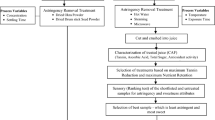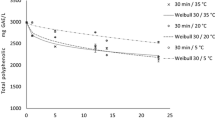Abstract
Epidemiological studies have related the consumption of fruits and vegetables to a lower risk of chronic diseases. Phytochemicals are held responsible for these desired effects; vitamin C and phenolic compounds being the most important ones in strawberries and raspberries. With respect to their role in health, it is valuable to study possible changes of these bioactive compounds during processing of fruits. In the present study, total phenolics, anthocyanins and vitamin C were firstly characterised in strawberries, raspberries and their juices. Thermal and high-pressure processes were screened for their effect on the bioactive compounds by treating strawberries and raspberries at different temperature–pressure combinations for one fixed treatment time (20 min). Thermal processing at atmospheric pressure (50–140 °C) had a degradative effect on anthocyanins and vitamin C. High-pressure processing (400, 600, 700 MPa combined with 20, 50, 80, 110 °C) showed no significant effect on the bioactive compounds in function of pressure. Breakdown of anthocyanins and vitamin C did occur at constant elevated pressure as temperature increased. No clear trends were perceptible for the amount of phenolic substances during processing.





Similar content being viewed by others
References
Hannum SM (2004) Potential impact of strawberries on human health: a review of the science. Crit Rev Food Sci Nutr 44:1–17
Ness AR, Powles JW (1997) Fruit and vegetables, and cardiovascular disease: a review. Int J Epidemiol 26:1–13
Steinmetz KA, Potter JD (1996) Vegetables, fruit, and cancer prevention: a review. J Am Diet Assoc 96:1027–1039
Gonzalez EM, de Ancos B, Cano MP (2003) Relation between bioactive compounds and free radical-scavenging capacity in berry fruits during frozen storage. J Sci Food Agric 83:722–726
Scalbert A, Williamson G (2000) Dietary intake and bioavailability of polyphenols. J Nutr 130:2073S–2085S
Croft KD (1998) The chemistry and biological effects of flavonoids and phenolic acids. Ann N Y Acad Sci 854:435–442
Padayatty SJ, Katz A, Wang YH, Eck P, Kwon O, Lee JH, Chen SL, Corpe C, Dutta A, Dutta SK, Levine M (2003) Vitamin C as an antioxidant: evaluation of its role in disease prevention. J Am Coll Nutr 22:18–35
Holdsworth D (2009) In: Simpson R (ed) Engineering aspects of thermal food processing. CRC Press, Boca Raton
Matser AA, Krebbers B, van den Berg RW, Bartels PV (2004) Advantages of high pressure sterilisation on quality of food products. Trends Food Sci Technol 15:79–85
Mujica-Paz H, Valdez-Fragoso A, Samson CT, Welti-Chanes J, Torres JA (2011) High-pressure processing technologies for the pasteurization and sterilization of foods. Food Bioprocess Technol 4:969–985
Rendueles E, Omer MK, Alvseike O, Onso-Calleja C, Capita R, Prieto M (2011) Microbiological food safety assessment of high hydrostatic pressure processing: a review. Lwt Food Sci Technol 44:1251–1260
Wilson DR, Dabrowski L, Stringer S, Moezelaar R, Brocklehurst TF (2008) High pressure in combination with elevated temperature as a method for the sterilisation of food. Trends Food Sci Technol 19:289–299
Barbosa-Canovas GV, Juliano P (2008) In: Gutierrez-Lopez GF, Barbosa-Canovas GV, Welti-Chanes J, Parada-Arias E (eds) Food engineering: integrated approaches. Springer, New York
Hong V, Wrolstad RE (1990) Use of HPLC separation photodiode array detection for characterization of anthocyanins. J Agric Food Chem 38:708–715
Lykkesfeldt J (2000) Determination of ascorbic acid and dehydroascorbic acid in biological samples by high-performance liquid chromatography using subtraction methods: reliable reduction with tris[2-carboxyethyl] phosphine hydrochloride. Anal Biochem 282:89–93
Kall MA, Andersen C (1999) Improved method for simultaneous determination of ascorbic acid and dehydroascorbic acid, isoascorbic acid and dehydroisoascorbic acid in food and biological samples. J Chromatogr B 730:101–111
Benvenuti S, Pellati F, Melegari M, Bertelli D (2004) Polyphenols, anthocyanins, ascorbic acid, and radical scavenging activity of Rubus, Ribes, and Aronia. J Food Sci 69:C164–C169
da Silva FL, Escribano-Bailon MT, Alonso JJP, Rivas-Gonzalo JC, Santos-Buelga C (2007) Anthocyanin pigments in strawberry. Lwt Food Sci Technol 40:374–382
Goiffon JP, Mouly PP, Gaydou EM (1999) Anthocyanic pigment determination in red fruit juices, concentrated juices and syrups using liquid chromatography. Anal Chim Acta 382:39–50
Patras A, Brunton NP, Da Pieve S, Butler F (2009) Impact of high pressure processing on total antioxidant activity, phenolic, ascorbic acid, anthocyanin content and colour of strawberry and blackberry purees. Innov Food Sci Emerg Technol 10:308–313
Pilnik W (1982) Enzymes in the beverage industry—fruit juices, nectars, wine and beer. Industrie Alimentari 21:585
Wightman JD, Wrolstad RE (1996) beta-Glucosidase activity in juice-processing enzymes based on anthocyanin analysis. J Food Sci 61:544
Wrolstad RE, Wightman JD, Durst RW (1994) Glycosidase activity of enzyme preparations used in fruit juice processing. Food Technol 48:90
Versari A, Biesenbruch S, Barbanti D, Farnell PJ, Galassi S (1997) Effects of pectolytic enzymes on selected phenolic compounds in strawberry and raspberry juices. Food Res Int 30:811–817
Bagger-Jorgensen R, Meyer AS (2004) Effects of different enzymatic pre-press maceration treatments on the release of phenols into blackcurrant juice. Eur Food Res Technol 219:620–629
Buchert J, Koponen JM, Suutarinen M, Mustranta A, Lille M, Torronen R, Poutanen K (2005) Effect of enzyme-aided pressing on anthocyanin yield and profiles in bilberry and blackcurrant juices. J Sci Food Agric 85:2548–2556
Landbo AK, Meyer AS (2001) Enzyme-assisted extraction of antioxidative phenols from black current juice press residues (Ribes nigrum). J Agric Food Chem 49:3169–3177
de Ancos B, Gonzalez E, Cano MP (1999) Differentiation of raspberry varieties according to anthocyanin composition. Zeitschrift fur Lebensmittel-Untersuchung Und-Forschung A. Food Res Technol 208:33–38
Garcia-Viguera C, Zafrilla P, Tomas-Barberan FA (1997) Determination of authenticity of fruit jams by HPLC analysis of anthocyanins. J Sci Food Agric 73:207–213
Mullen W, Stewart AJ, Lean MEJ, Gardner P, Duthie GG, Crozier A (2002) Effect of freezing and storage on the phenolics, ellagitannins, flavonoids, and antioxidant capacity of red raspberries. J Agric Food Chem 50:5197–5201
Pantelidis GE, Vasilakakis M, Manganaris GA, Diamantidis G (2007) Antioxidant capacity, phenol, anthocyanin and ascorbic acid contents in raspberries, blackberries, red currants, gooseberries and cornelian cherries. Food Chem 102:777–783
Jiang J, Paterson A, Piggott JR (1990) Effects of pectolytic enzyme treatments on anthocyanins in raspberry juice—short communication. Int J Food Sci Technol 25:596–600
Landbo AK, Kaack K, Meyer AS (2007) Statistically designed two step response surface optimization of enzymatic prepress treatment to increase juice yield and lower turbidity of elderberry juice. Innov Food Sci Emerg Technol 8:135–142
Meyer AS (2005) Enzymatic upgrading of antioxidant phenolics in berry juice and press residues. Fruit Process 6:382–387
Sadilova E, Carle R, Stintzing FC (2007) Thermal degradation of anthocyanins and its impact on color and in vitro antioxidant capacity. Mol Nutr Food Res 51:1461–1471
Zabetakis I, Leclerc N, Kajda P (2000) The effect of high hydrostatic pressure on the strawberry anthocyanins. J Agric Food Chem 48:2749–2754
Suthanthangjai W, Kajda P, Zabetakis L (2005) The effect of high hydrostatic pressure on the anthocyanins of raspberry (Rubus idaeus). Food Chem 90:193–197
Belitz H-D, Grosch W, Schieberle P (2004) Food chemistry. Springer, Berlin
Sancho F, Lambert Y, Demazeau G, Largeteau A, Bouvier JM, Narbonne JF (1999) Effect of ultra-high hydrostatic pressure on hydrosoluble vitamins. J Food Eng 39:247–253
Taoukis PS, Panagiotidis P, Stoforos NG, Butz P, Fister H, Tauscher B (1998) In: Isaacs NS (ed) High pressure food science, bioscience and chemistry. The Royal Society of Chemistry, Cambridge
Singleton VL, Rossi JA (1965) Colorimetry of total phenolics with phosphomolybdic-phosphotungstic acid reagents. Am J Enol Viticult 16:144–158
Prior RL, Wu XL, Schaich K (2005) Standardized methods for the determination of antioxidant capacity and phenolics in foods and dietary supplements. J Agric Food Chem 53:4290–4302
Klopotek Y, Otto K, Bohm V (2005) Processing strawberries to different products alters contents of vitamin C, total phenolics, total anthocyanins, and antioxidant capacity. J Agric Food Chem 53:5640–5646
Cao XM, Zhang Y, Zhang FS, Wang YT, Yi JY, Liao XJ (2011) Effects of high hydrostatic pressure on enzymes, phenolic compounds, anthocyanins, polymeric color and color of strawberry pulps. J Sci Food Agric 91:877–885
Acknowledgments
This research has been carried out with the financial support from the Institute for the Promotion of Innovation through Science and Technology in Flanders (IWT-Vlaanderen).
Author information
Authors and Affiliations
Corresponding author
Rights and permissions
About this article
Cite this article
Verbeyst, L., Hendrickx, M. & Van Loey, A. Characterisation and screening of the process stability of bioactive compounds in red fruit paste and red fruit juice. Eur Food Res Technol 234, 593–605 (2012). https://doi.org/10.1007/s00217-012-1667-1
Received:
Revised:
Accepted:
Published:
Issue Date:
DOI: https://doi.org/10.1007/s00217-012-1667-1




